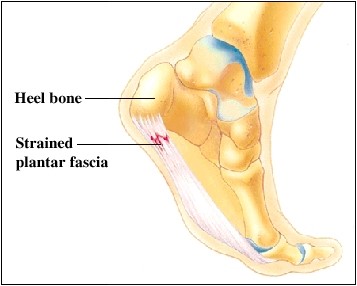Frequently Asked Questions
What exercises can help alleviate sore heel pain?
Exercises that can help alleviate sore heel pain include stretching the Achilles tendon and plantar fascia, strengthening the foot and ankle muscles, and low-impact activities like swimming or cycling.
What is the most common cause of plantar heel pain?
The most common cause of plantar heel pain is plantar fasciitis, which is inflammation of the thick band of tissue (plantar fascia) running along the bottom of the foot.
Can physical therapy help plantar heel pain?
Physical therapy can help manage plantar heel pain by addressing underlying issues, improving flexibility, and strengthening the affected area to reduce pain and prevent recurrence.
What causes plantar fasciitis in runners?
Plantar fasciitis in runners is commonly caused by overuse, excessive pronation, and wearing improper footwear, which can lead to inflammation and irritation of the plantar fascia.
What are the symptoms of plantar fasciitis in the early stages?
The early symptoms of plantar fasciitis may include heel pain, especially with first steps in the morning, and stiffness in the heel and arch of the foot.
How to tape a plantar heel for support?
Taping the plantar heel can provide support and relief for heel pain. Wrap the tape around the heel, across the arch, and over the top of the foot to stabilize the area.
What is the best shoe for plantar heel relief?
The best shoe for plantar heel relief typically features good arch support, cushioning, and a rigid sole to minimize stress on the plantar fascia.
How to treat a sore heel from plantar fasciitis?
Treating a sore heel from plantar fasciitis involves rest, ice, compression, and elevation (RICE) to reduce inflammation, as well as stretching and strengthening exercises to support the foot.
Can I prevent plantar fasciitis from coming back?
Preventing the recurrence of plantar fasciitis involves maintaining proper foot support, stretching exercises, and managing any underlying conditions that may contribute to the condition.
What is the main cause of plantar heel pain in athletes?
The main cause of plantar heel pain in athletes is repetitive stress and overuse of the plantar fascia, the connective tissue that runs along the bottom of the foot, often due to high-impact activities.
Can plantar fasciitis be treated without surgery?
Yes, plantar fasciitis can often be treated without surgery. Conservative treatments such as stretching, physical therapy, and the use of orthotics or night splints can help manage the condition and alleviate symptoms.
What are the symptoms of a plantar heel spur?
The symptoms of a plantar heel spur include a sharp or dull pain in the heel, especially when walking or standing, as well as tenderness and swelling in the affected area.
How to relieve sore heel pain at night?
Relieving sore heel pain at night can be achieved by icing the affected area, stretching the calf muscles, and using a night splint to keep the foot in a neutral position.
How to diagnose plantar fasciitis in the heel?
Diagnosing plantar fasciitis in the heel typically involves a physical examination, where the healthcare provider will assess the location and severity of heel pain, as well as consider the patient's medical history and symptoms.
What causes a sore heel after running or jogging?
A sore heel after running or jogging is often caused by plantar fasciitis, a condition that involves inflammation of the thick band of tissue connecting the heel bone to the toes.
What are the best shoes for plantar fasciitis sufferers?
The best shoes for plantar fasciitis sufferers are those with ample arch support, cushioning, and a stable heel counter to help reduce stress on the plantar fascia.
How to relieve plantar heel pain at night?
Relieving plantar heel pain at night involves stretching the foot, using ice packs, and wearing supportive footwear or night splints to reduce inflammation and tension in the plantar fascia.
How does plantar fasciitis affect daily activities?
Plantar fasciitis can make daily activities like walking, standing, and exercising painful and challenging, significantly impacting one's mobility and quality of life.
What are the symptoms of plantar fasciitis in the morning?
The symptoms of plantar fasciitis in the morning typically include sharp, stabbing pain in the heel or arch of the foot when first stepping out of bed, which may gradually improve with movement and activity.
What are the risks of untreated plantar heel pain?
The risks of untreated plantar heel pain include increased inflammation, worsening of symptoms, altered gait, and potential development of other foot problems if the underlying condition is not addressed.
What are the best exercises for plantar fasciitis relief?
The best exercises for plantar fasciitis relief include stretching the calf muscles, toe curls, and using a resistance band to strengthen the foot muscles. These exercises can help reduce pain and improve flexibility.
Can flat feet contribute to a sore heel?
Yes, flat feet can contribute to a sore heel. Flat feet often lead to excessive strain on the plantar fascia, causing inflammation and pain in the heel area.
Can plantar heel pain be treated with exercise?
Yes, plantar heel pain can often be treated with targeted exercises and stretches. Specific exercises can help strengthen the foot and calf muscles, improving support for the plantar fascia and reducing heel pain.
How long does it take to recover from plantar fasciitis?
The recovery time for plantar fasciitis can vary, typically ranging from several weeks to several months, depending on the severity of the condition and the effectiveness of the treatment plan.
What stretches help relieve plantar heel pain?
Stretches that can help relieve plantar heel pain include calf raises, toe curls, and rolling the foot over a tennis ball or frozen water bottle. These exercises can help strengthen the foot and calf muscles and improve flexibility.
How can I improve my foot arch support?
Improving your foot arch support can be achieved by using arch supports or orthotics, wearing supportive shoes, and performing foot strengthening exercises.
What footwear is best for heel pain relief?
Footwear that provides good arch support, cushioning, and heel stabilization can help relieve heel pain. Shoes with thick, shock-absorbing soles and proper heel cups are recommended for managing heel discomfort.
Are there specific exercises for plantar fasciitis?
Yes, there are specific exercises that can help manage plantar fasciitis. These exercises focus on stretching and strengthening the muscles and tissues in the foot and lower leg to reduce pain and promote healing.
How does weight affect plantar fasciitis symptoms?
Excess weight can exacerbate plantar fasciitis symptoms by placing additional stress and strain on the plantar fascia, leading to increased inflammation, pain, and difficulty with weight-bearing activities.
What home remedies alleviate sore heel discomfort?
Home remedies that can help alleviate sore heel discomfort include applying ice packs, performing stretching exercises, using over-the-counter pain medications, and wearing supportive footwear.



